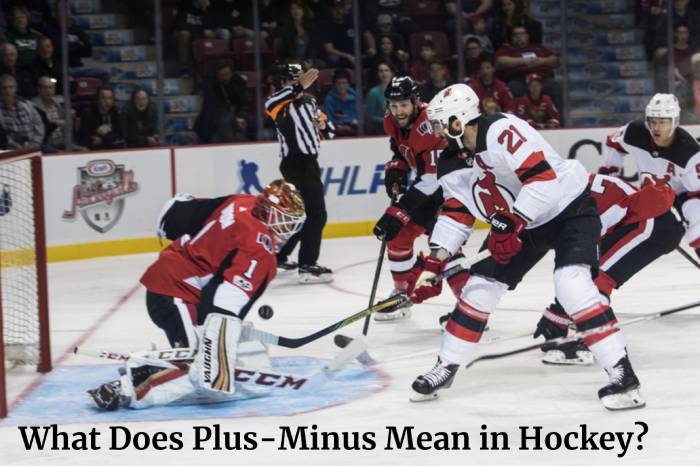During an ice hockey game, the plus-minus (+/-) statistic measures how many goals a player scores versus how many goals he concedes. Although there is some controversy surrounding the significance of the statistic, fans should understand why teams keep track of it. Here’s everything you need to know about +/-, how to calculate it, and why it’s so important!

Table of Contents
How is Plus-Minus Calculated in the NHL?
The plus-minus rating of a player is determined by the scoring that occurs while he is on the ice. The player’s plus/minus score will be updated if his or her team scores even-strength or shorthanded. The plus-minus score of the player will be reduced if the other team scores an even-strength or shorthanded goal while he or she is on the ice.
How Important is Plus-Minus in Hockey
In ice hockey, plus-minus is an important statistic for assessing how defensively responsible players are. The plus-minus values of players who do not protect their net or create scoring chances will naturally be low. There are, however, many factors that can distort this stat, such as the specific situations a player encounters during a hockey game.
What are Hockey Scenarios to Keep in Mind for this Stat?
The plus-minus only applies to goals scored at even strength or shorthanded. The plus-minus totals of hockey players on the ice are not adjusted when a team scores on a power-play goal. In the same way, shootout goals and penalty shots do not count toward a player’s plus-minus.
A team’s plus-minus rating is affected by empty net goals. Therefore, pulling the goalie can adversely affect the plus-minus stats of the players on the ice. A goalie being pulled from the net is an example of how supporters might argue that the statistics are flawed. In addition to increasing your chances of scoring, removing the goalie dramatically increases your chances of giving up a goal.
What are Examples Where the Stat Falls Flat?
Players who serve frequently on the penalty kill may have lower plus-minus values than those who operate on the power play. Despite power-play goals not counting towards plus-minus, if a penalty kill unit gets stuck on the ice after the penalty or has a late line change, the skaters may be tired and more likely to allow goals. Their plus-minus can be affected by late-shift, even-strength goals.
The opposing team’s top line may play against players deep in the roster, such as those on the third and fourth lines. As a result of this imbalance in skill level, their plus and minus ratings may decrease as a result of more dangerous scoring opportunities.
Do Power Plays Impact a +/- Score?
Players’ plus and minus scores are not affected by powerplays. However, if the other shorthanded team scores a goal, it will count toward their plus-minus.
When Did the NHL Adapt the Plus-Minus Score?
It was the Montreal Canadiens who first tracked plus-minus stats for their players in the 1950’s. Soon after, other teams began tracking their players’ performance on the ice with this metric. This stat was first officially included in NHL statistics in 1967-68.
What’s a Good Plus-Minus Value?
The best outcome for most players is to have a positive plus-minus value. The skaters with the most goals have been on the ice the longest. Positive plus-minus values also indicate that players aren’t defensive liability and aren’t giving up too many even-strength goals.
Plus-minus rankings will even be appreciated by most people. In spite of a plus-minus of zero, plus one, or minus one, a player may still be considered favorably since they protect the score. As a result, they can chew up minutes and burn time on the clock, helping a team win or keep the game close.
Plus-Minus Leaders in History
Defensemen account for three of the top three all-time plus-minus leaders. The Montreal Canadiens’ Larry Robinson has the highest plus-minus of all players at +722. For their time with the Boston Bruins, Bobby Orr and Ray Bourque hold the number two and three spots, respectively.
Only three of the top ten plus-minus leaders are forwards. All forwards are topped by Wayne Gretzky with a whopping +520. After Wayne Gretzky of the Philadelphia Flyers and Bryan Trottier of the New York Islanders, Bobby Clark follows them.
Was There an Award?
The NHL traditionally awarded a player with the highest plus-minus rating a yearly award. NHL players had to dress for a minimum of 60 games during the regular season or playoffs to qualify. When Pavel Datsyuk won the award for the Detroit Red Wings during the 2007-08 season, the award ceased to exist.
Comparing a +/- Stat to Other Hockey Stats
Fans can better understand a player’s worth to a team by comparing it to other standard statistics. A player with a high plus-minus should, theoretically, have a high assist total. There are only six players on the ice during the goal, so one of them is likely to have an assist.
Additionally, shooting percentage and ice time are other metrics that can help someone determine if a player’s plus-minus is accurate.
Conclusion: What is a Plus-Minus in Hockey
A plus-minus stat measures how offensively and defensively responsible a player is on the ice. Plus-minuses are important for players, since they mean they’re on the ice during a lot of goals. This statistic can, however, be distorted by a number of factors, so it is essential to use additional stat metrics when measuring a player’s impact.
